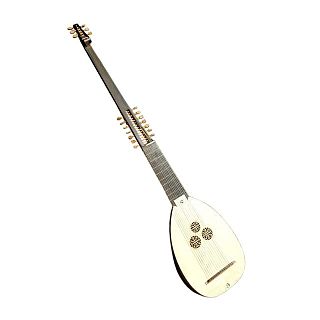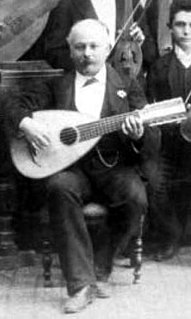
The theorbo is a plucked string instrument of the lute family, with an extended neck and a second pegbox. Like a lute, a theorbo has a curved-back sound box with a wooden top, typically with a sound hole, and a neck extending out from the soundbox. As with the lute, the player plucks or strums the strings with one hand while "fretting" the strings with the other hand; pressing the strings in different places on the neck produces different pitches (notes), thus enabling the performer to play chords, basslines and melodies.

Francesco Corbetta was an Italian guitar virtuoso, teacher and composer. Along with his compatriots Giovanni Paolo Foscarini and Angelo Michele Bartolotti, He was a pioneer and exponent of the combination of strummed and plucked textures referred to today as "mixed" style.
Giovanni Girolamo Kapsperger was a German-Italian virtuoso performer and composer of the early Baroque period. A prolific and highly original composer, Kapsberger is chiefly remembered today for his lute and theorbo (chitarrone) music, which was seminal in the development of these as solo instruments.
Robert de Visée was a lutenist, guitarist, theorbist and viol player at the court of the French kings Louis XIV and Louis XV, as well as a singer and composer for lute, theorbo and guitar.

The Baroque guitar is a string instrument with five courses of gut strings and moveable gut frets. The first course sometimes used only a single string.
Giovanni Battista Granata was an Italian Baroque guitar player and composer. He is generally known as the most prolific guitarist of the 17th century, publishing seven books during his lifetime. Along with many pieces in the standard dance genre of that time, Granata also composed many instrumental toccatas, preludes, and chaconnes. Granata was a barber-surgeon by profession.

Chitarra Italiana is a lute-shaped plucked instrument with four or five single strings, in a tuning similar to that of the guitar. It was common in Italy during the Renaissance era.
Michelagnolo Galilei was an Italian composer and lutenist of the late Renaissance and early Baroque eras, active mainly in Bavaria and Polish–Lithuanian Commonwealth. He was the son of music theorist and lutenist Vincenzo Galilei, and the younger brother of the scientist Galileo Galilei.
The year 1606 in music involved some significant events.

Carlo Carfagna is an Italian classical guitarist, author of many musical publications. His musical education took place at the Conservatory of Rome and Naples, under the guidance of Mario Gangi, and was subsequently a teaching colleague for many years at Santa Cecilia.
Angelo Berardi was an Italian music theorist and composer.
Roberto Fabbri is an Italian classical guitarist, composer, teacher and writer.
Lelio Colista was an Italian Baroque composer, lutenist, and guitarist.
Giovanni Paolo Foscarini was an Italian guitarist, lutenist, theorist and composer.

Giuseppe Branzoli was a violinist, mandolinist, composer, author, educator at the Liceo Musicale di St. Cecilia in Rome, and the founder of the periodical IL mandolin Romano. His compositions were for violin, mandolin, flute and cello, as well as church music.
Lodovico Monte was an Italian music editor and player of the Baroque guitar born in Bologna some time in the early 17th century.
Lex Eisenhardt is a performer and recording artist on early plucked instruments, such as the vihuela, the baroque guitar, and the 19th-century Romantic guitar. He studied lute and guitar at the Utrecht Conservatory. In 1981 he was appointed professor of guitar and early plucked instruments at the Sweelinck Conservatorium. In the forefront of the Historically Informed Performance (HIP) on the guitar, Eisenhardt was the first to make several gramophone recordings with music by the Catalan composer Fernando Sor on a period instrument from the early 19th century. He has given solo recitals and lectures in many European countries, Australia, and the United States. Well-known guitarists such as Johannes Moller and Izhar Elias studied with him.
Antonio Carbonchi was a 17th-century guitarist and composer who wrote two influential books on lute playing.

Maria Rita Brondi was an Italian guitarist, lutenist, singer, composer, and music historian.







